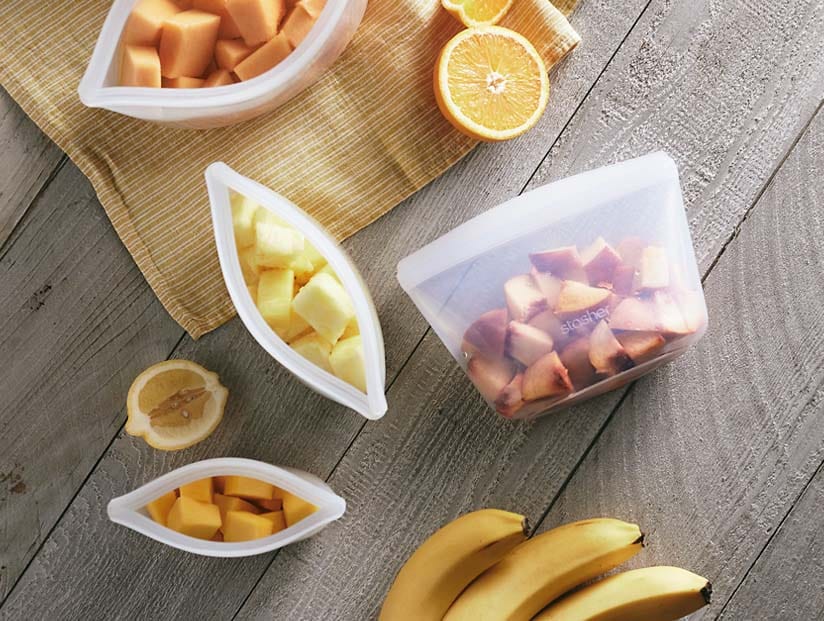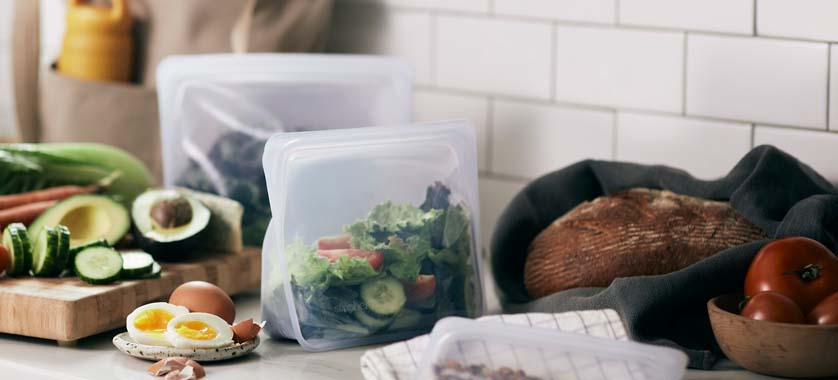
How to Clean & Sterilize Breast Pump Parts
If you’re pumping, then you probably already know the convenience of having pumped milk on hand, like more control over the timing of feedings (especially when traveling), or the option of being able to share feeding duties with another caregiver or family member.
What’s not so convenient? Cleaning and sterilizing breast pump parts after a pumping session. But rest assured, it doesn’t have to be as difficult or time consuming as it may seem — Stasher bags and bowls make sterilizing super easy, quick, and efficient. So whether you’re exclusively pumping, pumping after breastfeeding, or pumping while you’re away from your baby, consult the CDC Guidelines then read on for our tips on how to make sterilizing breast pump parts a breeze — and waste free.
Cleaning vs. Sterilizing
So what’s the difference between cleaning and sterilizing? Basically, cleaning is what you should do after every pumping session, using warm, soapy water to keep your breast pump clean and functioning properly. Sterilizing should be done less frequently (we’ll get into that in a minute), but is no less important! Sterilizing your breast pump parts is essentially extra protection for both you and your little one, helping to eradicate germs and harmful bacteria.
How to Clean Breast Pump Parts
After every pumping session, be sure to clean your breast pump parts. The same basic steps apply to most types of breast pumps (for instance, you should never immerse electrical units for powered breast pumps). Of course, if you have specific questions about your exact breast pump, be sure to dig out the instruction manual and double-check its cleaning directions.
In general, though, here’s how to clean a breast pump:
-
Step 1: First, give your breast pump a quick clean with disinfectant wipes – this will make the following steps a lot easier. (This is also the best method for when your pump needs a quick clean while you’re out and about.)
-
Step 2: Next, take apart your breast pump kit — we’re going to start with just the separate parts that came into direct contact with breast milk. Rinse these parts under cool running water. (If you’re concerned about hard water, you can use drinking-quality water instead.)
-
Step 3: To ensure that breast pump parts don’t touch the sink and pick up germs, use a clean wash basin or large bowl that you reserve only for this cleaning routine. For this part, use hot, soapy water with a clean rag or a small soft-bristled brush, which can make it easier to reach harder-to-clean areas, like breast pump tubing and membranes. And just like with the wash basin, make sure your rag or brush is clean and reserved for cleaning your breast pump parts — nothing else. For soap, opt for a regular dish soap instead of anything antibacterial, which can be loaded with extra chemicals.
Alternatively, you can put your breast pump parts into the top rack of the dishwasher. Pop small parts like flanges and membranes into a dishwasher-safe basket with a lid or a washable mesh bag – this keeps them all in one spot so they don’t fly around mid-cycle. For the deepest clean, use the hot water and heated dry settings on the dishwasher. And remember, when in doubt, always check the manufacturer instructions that came with your pump.
- Step 4: Whether you washed your pump parts in a bowl or in the dishwasher, the next step is to air dry them. If possible, use clean tongs to transfer your pump parts from the bowl or dishwasher rack to a clean paper towel. (Typically, we’re big proponents of reusable solutions. But in this case, using a paper towel is more sanitary for you and your little one than using a dish towel — use your own discretion!)
How to Sterilize Breast Pump Parts
There are several ways to sterilize breast pump parts, but the main three are steaming, boiling, or using a dishwasher. Each has its own pros and cons, so read on to find out which method is the best fit for you.

Use Microwave Sterilizer Bags
Moist heat from super saturated steam in microwave sterilizer bags is a quick, easy, nontoxic way to kill germs. After cleaning your breast pump parts by using one of the methods listed above, place all microwave-safe parts in a Stand-Up Stasher Bag or Stasher Bowl along with 2 ounces of water. Keep the seal open — at least 2 inches — so that the steam has a place to escape, and microwave on high for 5 minutes (may vary depending on the voltage of your microwave) — or however long the pump manufacturer’s instructions recommend. The steam can burn your skin, so use tongs when removing the bag from the microwave and place it on a towel or heat-resistant countertop to cool. Use clean tongs to remove the pump parts and place them on a paper towel to air dry.
Boil Breast Pump Parts
The boiling method is another effective means of at-home sterilization. Simply place all breast pump parts that are safe to boil into a pot filled with water and bring to a boil. Let the water stay at a full rolling boil for five minutes, then use clean tongs to remove the parts from the boiling water and transfer them to a paper towel to cool and air dry.
Sterilize Breast Pump Parts in the Dishwasher
If your dishwasher has a sanitize setting, you can also use it in conjunction with step 3 of cleaning your breast pump parts in the dishwasher as described above. As with that method, place the disassembled parts in the top rack of the dishwasher, taking care to collect small parts into a dishwasher-safe lidded basket or mesh laundry bag. Instead of just using the hot water and heated dry settings, opt for the sanitize setting, which increases the temperature of both the main wash and the final rinse.
How Often to Sterilize Breast Pump Parts
While it’s important to clean your breast pump parts after every use, you don’t have to sanitize them every single time. Instead, the CDC recommends sanitizing your breast pump once a day if your baby is under 2 months old, was born prematurely, and/or has a weakened immune system. It’s also important to go through the sanitization process when your equipment is brand new or hasn’t been used in a long time. That way, you can protect both yourself and your little one.
The microwave steam method is our go-to method because it uses minimal water, keeps even the smallest of pump parts in one spot, and is quick to clean up – when you’re done, just pop your Stasher bag or bowl into the dishwasher so it’s ready to go for the next use.
And if your baby is growing up fast and you’re wondering when it’s time for solid foods, check this out: When Do Babies Start Eating Baby Food?
References: Cleaning a Breast Pump (FDA.gov); How to Keep Your Breast Pump Clean (CDC.gov)








